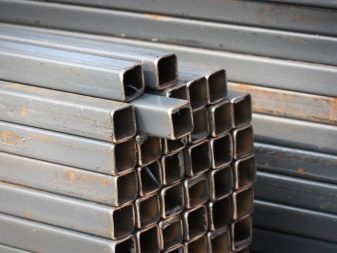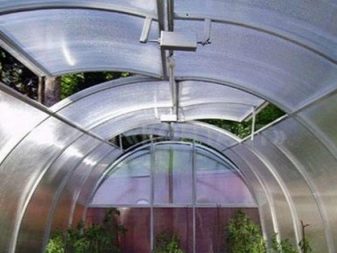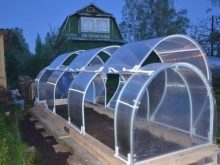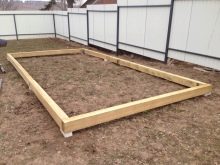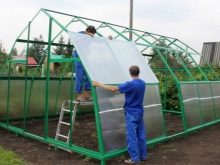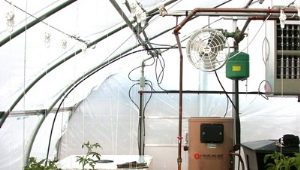Greenhouses for grapes: design features
Grown in greenhouse conditions, the grape can give a higher yield than that grown in open soil. Moreover, in areas with cold climatic conditions, the grapes simply do not have time to ripen. A properly equipped greenhouse for a sunny berry can become a protector of a thermophilic culture from the vagaries of nature.
Design features
Buildings designed for the cultivation of grapes, have certain characteristics. The first thing that affects the size of the greenhouse. The height of the structure must be at least 2.5 meters. Metric area of the greenhouse must have at least 25 square meters. m. To protect the grapes from freezing, under the greenhouse it is imperative to arrange the foundation. A quality foundation will also prevent the structure from invading weeds and damaging parasites. Covering material for this kind of greenhouses, as a rule, is cellular polycarbonate.This material has proper thermal insulation properties, light passes perfectly through it.
For unheated structures can be applied covering film of polyethylene. For the cultivation of grapes requires a solid and durable structure, since in the first year the vineyard may not bear fruit.
A solid skeleton of the structure is needed for its long-term use. The core can be made of galvanized profile or shaped pipes.
For the cultivation of grapes that do not tolerate low positive temperatures, the greenhouse must be equipped with heating. In the role of heating installations it is possible to use infrared heating lamps (IR lamps). They are defined in the area of the ceiling. When using such devices, the skeleton of the greenhouse will need to be thoroughly strengthened.
An alternative to IR lamps can be a specialized heating cable, held underground. Some varieties of solar berries need a lot of light. In the northern regions, the deficit of the sun can be compensated by means of lighting devices. As a rule, low pressure mercury lamps (fluorescent lamps) are used.
The design also needs to organize an airing system to preserve the microclimate. In order for the greenhouse to be ventilated in automatic mode, it is necessary to equip the vents of the building with hydraulic cylinders. This mechanism responds to changes in the temperature of the atmosphere inside the building. As the temperature inside the greenhouse increases, it opens the vents, and when the temperature drops, it closes them.
For irrigation, you can apply the system of automatic irrigation drip. The grapes do not need intensive irrigation.
Automated irrigation system greatly simplifies the care of plantings and delivers the required amount of moisture.
Species
For the cultivation of grapes, you can buy a ready-made structure or make it with your own hands. When choosing the type of greenhouse required, some principles of grape cultivation should be taken into account.
By type of covering material greenhouses under the vineyard are divided into 2 types.
- Polyethylene film. Polyethylene - the most inexpensive opportunity to cover greenhouses. Nevertheless, it does not have a long service life and is suitable only for the cultivation of unpretentious grape species.
- Polycarbonate honeycomb. The durability of this material is 200 times greater than glass. The greenhouse, sheathed with polycarbonate, perfectly covered from strong winds and precipitation.
At the same time, the material has a good translucency and a long-term service life. Designs of polycarbonate plates - this is the most advantageous option for the cultivation of grapes. The configuration of the structure is also of great importance for gardening.
Ideal options are two types of greenhouses.
- The construction is in the form of a rectangle with a roof having 2 slopes. This design ensures a good degree of lighting for plantations. The configuration of the greenhouse makes it possible to organize an acceptable height of facilities for viticulture.
- The structure in the form of a hemisphere (arch). This type of greenhouse has a low price and is characterized by ease of assembly. Such a construction, according to individual indicators, is losing to greenhouses in the form of a rectangle, but also suitable for growing vineyards.
Experienced winegrowers are advised to use a removable top for grapes. Such a sample makes it possible in the winter to protect the plants from freezing.
The removed roof provides access to precipitation (in particular, snow) inside the greenhouse, which allows the soil to soak in moisture, and the snow layer protects the roots of the vineyard from freezing.
Knowing the characteristics of greenhouses for grapes, you can make the desired design with your own hands. A similar method in comparison with the purchase of finished samples will provide an opportunity to build the most suitable structure and how to equip it.
Design development
When planning the future structure, it is necessary to decide on the size and configuration of the structure, to select materials from which the main elements of the structure will be assembled. Metric area of the greenhouse is determined by how many grape bushes are supposed to be planted. The recommended construction height is 2.5 meters. However, for some types of grapes will be suitable and more low structure.
For the construction of a polycarbonate greenhouse in the form of a hemisphere, the parameters of straight walls can be 4.2 x 1.5 meters. The height of the building in this situation will be 1.5 meters. The width of the greenhouse will depend on the angle of slope of the roof.In addition to the arched configuration, the structure in the shape of a rectangle with a roof having 2 sloping surfaces (slopes) is excellent for grapes.
A similar pattern can be constructed from wooden boards and cellular polycarbonate panels.
Making the base
Before building a greenhouse, it is advisable to build a foundation. The most frequently used option is a ribbon maladaptive foundation. The imperfection of this solution is the high probability of a negative impact on the roots of the vineyard. The concrete base is able to restrain the spread of the roots of the vineyard in width.
As an alternative, you can use metal corners measuring about a meter. At the bottom of the corner, small thick metal plates are welded on. For a large greenhouse complex, 14 similar support pins may be needed for placement around the perimeter and about 7 for center mounting.
Wreck assembly
For the construction of the frame will fit both iron and wood. It is much easier to work with wood bars, since no welding work will be required.Nevertheless, this material loses in a large number of parameters to the metal. The ideal option is the skeleton of galvanized. In the role of fasteners can be used aluminum rivets, screws or bolts.
If you have skills in welding, then it will be much easier to assemble the greenhouse by welding.
Mounting
The first step is the manufacture of the skeleton of the future structure. The profile from galvanization is cut on details of the required size. The frame is assembled or welded from components. To fix polycarbonate panels on the skeleton, you need to install specialized rubber gaskets. Polycarbonate panels are determined on the gaskets. At the points of butt joints, metal pads are fixed by means of self-tapping screws. Thus, having built a greenhouse, following all the recommendations, as well as caring for the vineyard competently, you can get an excellent result.
Review of greenhouses for grapes - in the next video.




